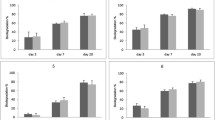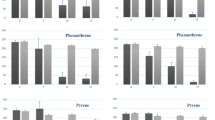Abstract
Marine harbor sediments are frequently polluted with significant amount of polycyclic aromatic hydrocarbons (PAHs) some of which are naturally toxic, recalcitrant, mutagenic, and carcinogenic. To stimulate biodegradation of PAHs in PAH-contaminated sediments collected from near Gwangyang Bay, Korea, lactate was chosen as a supplementary carbonaceous substrate. Sediment packed into 600 ml air-tight jar was either under no treatment condition or lactate amended condition (1%, w/v). Microbial community composition was monitored by bacteria-specific and archaea-specific PCR-terminal restriction fragment length polymorphism (T-RFLP), in addition to measuring the residual PAH concentration. Results showed that lactate amendment enhanced biodegradation rate of PAHs in the sediment by 4 to 8 times, and caused a significant shift in archaebacterial community in terms of structure and diversity with time. Phylogenetic analysis of 23 archaeal clones with distinctive RFLP patterns among 288 archaeal clones indicated that majority of the archaeal members were closest to unculturable environmental rDNA clones from hydrocarbon-contaminated and/or methanogenesis-bearing sediments. Lactate amendment led to the enrichment of some clones that were most closely related to PAH-degrading Methanosarcina species. These results suggest a possible contribution of methanogenic community to PAH degradation and give us more insights on how to effectively remediate PAH-contaminated sediments.
Similar content being viewed by others
References
Bach, Q.D., S.J. Kim, S.C. Choi, and Y.S. Oh. 2005. Enhancing the intrinsic bioremediation of PAH-contaminated anoxic estuarine sediments with biostimulating agents. J. Microbiol. 43, 319–324.
Biddle, J.F., J.S. Lipp, M.A. Lever, K.G. Lloyd, K.B. Sørensen, R. Andersonc, H.F. Fredricks, M. Elvert, T.J. Kelly, D.P. Schrag, M.L. Sogin, J.E. Brenchley, A. Teske, C.H. House, and K.U. Hinrichs. 2006. Heterotrophic Archaea dominate sedimentary subsurface ecosystems off Peru. Proc. Natl. Acad. Sci. USA 103, 3846–3851.
Campbell, B.J. and S.C. Cary. 2001. Characterization of a novel Spirochete associated with the hydrothermal vent polychaete annelid, Alvinella pompejana. Appl. Environ. Microbiol. 67, 110–117.
Chang, B.V., L.C. Shiung, and S.Y. Yuan. 2002. Anaerobic bio-degradation of polycyclic aromatic hydrocarbon in soil. Chemosphere 48, 717–724.
Chang, W., Y. Um, B. Hoffman, and T.R.P. Holoman. 2005. Molecular characterization of polycyclic aromatic hydrocarbon (PAH)-degrading methanogenic communities. Biotechnol. Prog. 21, 682–688.
Chang, W., Y. Um, and T.R.P. Holoman. 2006. Polycyclic aromatic hydrocarbon (PAH) degradation coupled to methanogenesis. Biotechnol. Lett. 28, 425–430.
Coates, J.D., J. Woodward, J. Allen, P. Philp, and D.R. Lovley. 1997. Anaerobic degradation of polycyclic aromatic hydrocarbons and alkanes in petroleum-contaminated marine harbor sediments. Appl. Environ. Microbiol. 63, 3589–3593.
Connon, S.A., A. Tovanabootr, M. Dolan, K. Vergin, S.J. Giovan-noni, and L. Semprini. 2005. Bacterial community composition determined by culture-independent and -dependent methods during propane-stimulated bioremediation in trichloroethene-contaminated groundwater. Environ. Microbiol. 7, 165–178.
Cullen, D.W. and P.R. Hirsch. 1998. Simple and rapid method for direct extraction of microbial DNA from soil for PCR. Soil Biol. Biochem. 30, 983–993.
Cuypers, M.P., T.C. Grotenhius, and W.H. Rulkens. 1998. Characterization of PAH contaminated sediments in a remediation perspective. Water Sci. Technol. 37, 157–164.
Delong, E. 1992. Archaea in coastal marine environments. Proc. Natl. Acad. Sci. USA 89, 5685–5689.
Dojka, M.A., P. Hugenholtz, S.K. Haack, and N.R. Pace. 1998. Microbial diversity in a hydrocarbon- and chlorinated-solvent-contaminated aquifer undergoing intrinsic bioremediation. Appl. Environ. Microbiol. 64, 3869–3877.
Ellis, R.J., P. Morgan, A.J. Weightman, and J. Fry. 2003. Cultivation-dependent and -independent approaches for determining bacterial diversity in heavy-metal contaminated soil. Appl. Environ. Microbiol. 69, 3223–3230.
Elshahed, M.S., F.Z. Najar, B.A. Roe, A. Oren, T.A. Dewers, and L.R. Krumholz. 2004. Survey of archaeal diversity reveals an abundance of halophilic archaea in a low-salt, sulfide-, and sulfur-rich spring. Appl. Environ. Microbiol. 70, 2230–2239.
Ferrarese, E., G. Andreottola, and I.A. Oprea. 2008. Remediation of PAH-contaminated sediments by chemical oxidation. J. Hazard. Mater. 152, 128–139.
Giovannoi, S.J. 1991. The polymerase chain reaction, p. 177–201. In E. Stackebrandt and M. Goodfellow (eds.), Nucleic acid techniques in bacterialsystematics. John Wiley & Sons, New York, N.Y., USA.
Gray, J.P. and R.P. Herwig. 1996. Phylogenetic analysis of the bacterial communities in marine sediment. Appl. Environ. Microbiol. 62, 4049–4059.
Haapea, P. and T. Tuhkanen. 2006. Integrated treatment of PAH contaminated soil by soil washing, ozonation, and biological treatment. J. Hazard. Mater. 136, 244–250.
Hayes, L.A., K.P. Nevin, and D.R. Lovley. 1999. Role of prior exposure on anaerobic degradation of naphthalene and phenanthrene in marine harbor sediments. Org. Geochem. 30, 937–945.
Henner, P., M. Schiavon, J.L. Morel, and E. Lichtfouse. 1997. Polycyclic aromatic hydrocarbon (PAH) occurrence and remediation methods. Anal. Mag. 25, 56–59.
Higashi, Y., M. Sunamura, K. Kitamura, K.I. Nakamura, Y. Kurusu, J.I. Ishibashi, T. Urabe, and A. Maruyama. 2004. Microbial diversity in hydrothermal surface to subsurface environments of Suiyo Seamount, Izu-Bonin Arc, using a catheter-type in situ growth chamber. FEMS Microbiol. Ecol. 47, 327–336.
Inagaki, F., T. Nunoura, S. Nakagawa, A. Teske, M. Lever, A. Lauer, M. Suzuki, K. Takai, M. Delwiche, F.S. Colwell, K.H. Nealson, K. Horikoshi, S. D’Hondt, and B.B. Jørgensen. 2006. Biogeographical distribution and diversity of microbes in methane hydrate-bearing deep marine sediments on the Pacific Ocean Margin. Proc. Natl. Acad. Sci. USA 103, 2815–2820.
Jukes, T.H. and C.R. Canter. 1969. Evolution of protein molecules, p. 21–132. In H.N. Munro (ed.), Mammalian protein metabolism. Academic Press, New York, N.Y., USA.
Karthikeyan, R. and A. Bhandari. 2001. Anaerobic biotransformation of aromatic and polycyclic aromatic hydrocarbons in soil microcosms: a review. J. Hazard. Subst. Res. 3, 1–19.
Kim, B., H.M. Oh, H.K. Kang, and J. Chun. 2005. Archaeal diversity in tidal flat sediment as revealed by 16S rDNA analysis. J. Microbiol. 43, 144–151.
Long, E.R., D.D. MacDonald, S.L. Smith, and F.D. Calder. 1995. Incidence of adverse biological effects within ranges of chemical concentrations in marine and estuary sediments. Environ. Manage. 19, 81–97.
Madigan, M.T., J.M. Martinko, and J. Parker. 2003. Biology of microorganisms, 10th ed., p. 453–455. Pearson Education, Inc., Upper Saddle River, NJ, USA.
Mai, B.S., J.M. Fu, G.Y. Sheng, Y.H. Kang, Z. Lin, and G. Zhang. 2002. Chlorinated and polycyclic aromatic hydrocarbons in riverine and estuarine sediments from Pearl River Delta, China. Environ. Pollut. 117, 457–474.
O’Mahony, M.M., A.D.W. Dobson, J.D. Barnes, and I. Singleton. 2006. The use of ozone in the remediation of polycyclic aromatic hydrocarbon contaminated soil. Chemosphere 63, 307–314.
Parkes, R.J., G. Webster, B.A. Cragg, A.J. Weightman, C.J. New-berry, T.G. Ferdelman, J. Kallmeyer, B.B. Jørgensen, I.W. Aiello, and J.C. Fry. 2005. Deep sub-seafloor prokaryotes stimulated at interfaces over geological time. Nature 436, 390–394.
Reed, D.W., Y. Fujita, M.E. Delwiche, D.B. Blackwelder, P.P. Sheridan, T. Uchida, and F.S. Colwell. 2002. Microbial communities from methane hydrate-bearing deep marine sediments in a forearc basin. Appl. Environ. Microbiol. 68, 3759–3770.
Rothermich, M.M., L.A. Hayes, and D.R. Lovley. 2002. Anaerobic, sulfate-dependent degradation of polycyclic aromatic hydrocarbons in petroleum-contaminated harbor sediment. Environ. Sci. Technol. 36, 4811–4817.
Saul, D.J., J.M. Aislabie, C.E. Brown, L. Harris, and J.M. Foght. 2005. Hydrocarbon contamination changes the bacterial diversity of soil from around Scott Base, Antarctica. FEMS Microbiol. Ecol. 53, 141–155.
Sekiguchi, Y., Y. Kamagata, K. Syutsubo, A. Ohashi, H. Harada, and K. Nakamura. 1998. Phylogenetic diversity of mesophilic and thermophilic granular sludges determined by 16S rRNA gene analysis. Microbiology 144, 2655–2665.
Takai, K., T. Komatsu, F. Inagaki, and K. Horikoshi. 2001a. Distribution of archaea in a black smoker chimney structure. Appl. Environ. Microbiol. 67, 3618–3629.
Takai, K., D.P. Moser, M. Deflaun, T.C. Onstott, and J.K. Fredrickson. 2001b. Archaeal diversity in waters from deep South African gold mines. Appl. Environ. Microbiol. 67, 5750–5760.
Taylor, L.T. and D.M. Jones. 2001. Bioremediation of coal tar PAH in soils using biodiesel. Chemosphere 44, 1131–1136.
Watanabe, K., Y. Kodama, N. Hamamura, and N. Kaku. 2002. Diversity, abundance, and activity of archaeal populations in oil-contaminated groundwater accumulated at the bottom of an underground crude oil storage cavity. Appl. Environ. Microbiol. 68, 3899–3907.
Wild, S.R. and K.C. Jones. 1995. Polynuclear aromatic hydrocarbons in the United Kingdom Environment: a preliminary source inventory and budget. Environ. Pollut. 88, 91–108.
Yuan, S.Y. and B.V. Chang. 2007. Anaerobic degradation of five polycyclic aromatic hydrocarbons from river sediment in Taiwan. J. Environ. Sci. Health B. 42, 63–69.
Zucchi, M., L. Angiolini, S. Borin, L. Brusetti, N. Dietrich, C. Gigliotti, P. Barbieri, and D. Daffonchio. 2003. Response of bacterial community during bioremediation of an oil-polluted soil. J. Appl. Microbiol. 94, 248–257.
Author information
Authors and Affiliations
Corresponding author
Rights and permissions
About this article
Cite this article
Kim, M., Bae, S.S., Seol, M. et al. Monitoring nutrient impact on bacterial community composition during bioremediation of anoxic PAH-contaminated sediment. J Microbiol. 46, 615–623 (2008). https://doi.org/10.1007/s12275-008-0097-z
Received:
Accepted:
Published:
Issue Date:
DOI: https://doi.org/10.1007/s12275-008-0097-z




